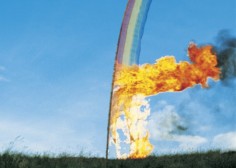RÚRÍ

source: xuku-vablogspot
Rúrí ha nacido en Islandia en 1951.Las personas pueden tener diferentes motivaciones para expresarse artísticamente, y para el arte Ruri es la lengua. Se le permite expresarse de una manera que no habría sido viable a través de la palabra escrita o hablada. Se toca en las cuestiones que importan a todos nosotros, que plantea cuestiones relativas a la vida y la convivencia, de la coherencia cósmica, que se opone a la relatividad de los objetos y los fenómenos y las consultas del sistema de coordenadas que el hombre ha creado para estructurar su entorno. Ruri arte no puede ser clasificado y etiquetado, que aparece en las más diversas formas: a veces fresco en el diseño, a continuación, inconcebiblemente poéticas, que pone al espectador por turnos en el papel de un espectador convencional o un participante activo. Sus obras son conceptuales, en el sentido de que están ligados a ideas precisas y se basa en la teoría o la percepción, pero todos tienen un aspecto tangible y sensorial.Su obra, gira en torno a cuestiones filosóficas fundamentales, las condiciones que ella misma utiliza para describir su motivación: la identidad, el tiempo, el cosmos, la relatividad y el medio ambiente.
El arco iris se materializa de la nada, tiene una duración de unos momentos y desaparece tan repentinamente como apareció. Nadie puede comprenderlo, ni
incluso acercarse a ella, sin embargo, tiene un valor muy especial para la mayoría de la gente.Instalacion / Rendimiento Altura de la instalación de 1.700 cm, duración de la ejecución de 20 min.
.
.
.
.
.
.
.
source: ruriis
People may have different motivations to express themselves artistically; and for Rúrí art is the language. It allows her to express herself in ways that would not have been viable through the written or spoken word. She touches on issues that matter to all of us; she raises questions concerning life and coexistence, of cosmic coherence; she challenges the relativity of objects and phenomena and queries the coordinate system that man has established to structure his surroundings. Rúrí’s art cannot be classified and labeled, it appears in the most diverse forms: sometimes cool in design, then inconceivably poetic, it puts the viewer by turns in the role of a conventional onlooker or an active participant. Her works are conceptual, in the sense that they are linked to precise ideas and based on theory or perception, but they all have a tangible and sensory aspect.
A list of all the forms of her artistic expression—such as performance, happening, drawing, sculpture, photography, video and so on—could lead us to expect a very heterogeneous oeuvre. But a closer look reveals an impressive consistency and almost unerringly logical development in her work, revolving around vital philosophical issues, terms she uses herself to describe her motivation: identity, time, cosmos, relativity and environment.
Christian Schoen, “Preface”, in: Rúrí monograph, Hatje Cantz, Ostfieldern 2011, pp.6.
Rúrí is born in Iceland in 1951.
.
.
.
.
.
.
.
source: hatjecantzde
Die isländische Künstlerin Rúrí (*1951 in Reykjavík) zählt zu den bedeutendsten nordeuropäischen Künstlerinnen. Ihr frühes Werk spiegelt die Spannungen einer Gesellschaft im Umbruch wider, und es zeugt von dem starken Willen, sich in der von Männern dominierten Kunstwelt zu behaupten. Fragen der eigenen und der kulturellen Identität beschäftigten Rúrí in den 1980er-Jahren. Beeinflusst von Fluxus und Konzeptkunst, gehört sie zu den ersten Performancekünstlerinnen in Nordeuropa. In Aktionen und Performances sowie Projekten im öffentlichen Raum, aber auch in poetischen Einzelobjekten setzte sie sich später mit allgemeinen ethischen Themen auseinander. Große internationale Aufmerksamkeit erlangte sie mit ihrem Archive – Endangered Waters auf der Biennale in Venedig 2003. Für Rúrí ist Kunst in Form übersetzte Philosophie, und wie kaum eine zweite Künstlerin wirft sie zentrale Fragen des Lebens auf.

